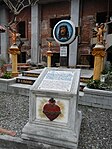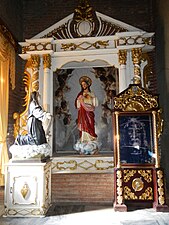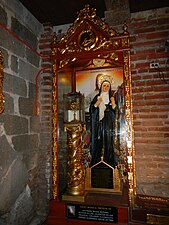
Mexico, officially the Municipality of Mexico, is a 1st class municipality in the province of Pampanga, the Philippines. According to the 2020 census, it has a population of 173,403 people. It was also formerly known as Nuevo México during the Spanish period.

Minalin, officially the Municipality of Minalin, is a 4th class municipality in the province of Pampanga, Philippines. According to the 2020 census, it has a population of 48,380 people.

The Archdiocese of San Fernando is the archdiocese of the Latin Church of the Catholic Church in Pampanga, Philippines which has territorial jurisdiction over the whole province of Pampanga and Angeles City. The archdiocese is also the metropolitan see of the ecclesiastical province of the same name, which also include three dioceses of its surrounding provinces of Bataan, Zambales, and Tarlac. The cathedral church and seat of the archdiocese is the Metropolitan Cathedral of San Fernando (Pampanga). The Virgin Mary, under the title Virgen de los Remedios, is the principal patroness.

San Guillermo Parish Church is a Roman Catholic church in Bacolor, Pampanga, Philippines. It is under the jurisdiction of the Archdiocese of San Fernando. Named after San Guillermo, the town's patron saint, the church was originally constructed by the Augustinian Friars in 1576 – also the town's founding – with Padre Diego de Ochoa, OSA, becoming the town's first parish priest two years later.

Santiago Apostol Parish Church, commonly known as Betis Church, is a Baroque-style church located in the Betis District of Guagua in Pampanga, Philippines under the Roman Catholic Archdiocese of San Fernando. The church was established in 1607 and dedicated to Saint James the Greater, the Apostle. It was declared a National Cultural Treasure by the National Museum and the National Commission for Culture and the Arts.

The Minor Basilica and Diocesan Shrine of Our Lady of Charity, also known as Santa Monica Parish Church and Agoo Basilica, is a Roman Catholic minor basilica in Agoo, La Union, Philippines dedicated to Our Lady of Charity. It is the seat of the Santa Monica Parish of the Diocese of San Fernando de La Union under the Vicariate of St. Francis Xavier. The basilica is under the leadership of parish priest Alfonso V. Lacsamana and parish vicar Liberato A. Apusen. It is situated along MacArthur Highway in front of the Jose D. Aspiras Civic Center.

The Diocesan Shrine and Parish of Saint Augustine, commonly known as Baliwag Church, is a Roman Catholic church located in Plaza Naning at the poblacion of Baliwag, in Bulacan province, Philippines. The church is a parish church of the Diocese of Malolos, which is a suffragan of the Archdiocese of Manila.

Santa Cruz Parish Church, also known as Holy Cross Parish Church and Maribojoc Church, is a Roman Catholic parish church in the municipality of Maribojoc, Bohol, Philippines, under the Diocese of Tagbilaran. The parish was first established by the Jesuits in 1767 or 1768 with Father Juan Soriano, SJ as its first parish priest. The Augustinian Recollects later administered the community until 1898.

The Archdiocesan Shrine and Parish of Saint Joseph the Patriarch, also known as Saint Joseph the Patriarch Church, is a Roman Catholic church located in the town center of San Jose, Batangas, in the Philippines. It is under the jurisdiction of the Archdiocese of Lipa. The church is known for being one of the parishes that Fr. Manuel Blanco OSA, who authored the Flora de Filipinas, administered.

Immaculate Conception Parish Church, also known as La Purisima Concepcion de la Virgen Maria Parish Church and Baclayon Church, is a Roman Catholic church in the municipality of Baclayon, Bohol, Philippines within the jurisdiction of the Diocese of Tagbilaran. Baclayon was founded by the Jesuit priest Juan de Torres and Gabriel Sánchez in 1596, and became the oldest Christian settlement in Bohol. It was elevated as a parish in 1717 and the present coral stone church was completed in 1727. The Augustinian Recollects succeeded the Jesuits in 1768 and heavily renovated the church since then.

San Pedro Apostol Parish Church, commonly known as Loboc Church and alternatively as the Diocesan Shrine of Our Lady of Guadalupe in Extremadura, is a Roman Catholic church in the municipality of Loboc, Bohol, Philippines, within the jurisdiction of the Diocese of Tagbilaran.

Santa Monica Parish Church, commonly known as Angat Church, is a Roman Catholic church in Angat, Bulacan, Philippines. It is under the jurisdiction of the Diocese of Malolos and is one of the oldest churches in Bulacan province, dating back to 1758. It displays Baroque architectural characteristics and features ceiling paintings which resemble those in the Sistine Chapel.

San Agustin Parish Church, commonly known as Lubao Church, is a 17th-century Neo-classic, Spanish stone and brick Roman Catholic church located at Brgy. San Nicolas 1st, Lubao, Pampanga, Philippines. It is under the jurisdiction of the Archdiocese of San Fernando. In 1952, a historical marker bearing a brief history of the structure was installed on the facade of the church by the Historical Committee of the Philippines, precursor of the National Historical Commission of the Philippines. In 2013, the church has been declared by the National Museum of the Philippines as an Important Cultural Property.

Saint Catherine of Alexandria Parish Church, commonly known as Porac Church, is a 19th-century Baroque Roman Catholic church located at Barangay Poblacion, Porac, Pampanga, Philippines. The parish church is currently under the ecclesiastical province of the Archdiocese of San Fernando.

San Nicolas de Tolentino Parish Church, commonly known as Macabebe Church, is a 17th-century, Baroque Roman Catholic church located at Barangay Santa Cruz, Macabebe, Pampanga, Philippines. The parish church, under the patronage of Saint Nicholas of Tolentine, is under the Archdiocese of San Fernando.

San Andres Apostol Parish Church, commonly known as Candaba Church, is a 17th-century, Baroque church located at Barangay Pescadores, Candaba, Pampanga, Philippines. The parish church, dedicated to Saint Andrew the Apostle, is under the Roman Catholic Archdiocese of San Fernando.

The National Shrine and Parish of Saint Anne, commonly known as Santa Ana Shrine or Hagonoy Church, is an 18th-century, Baroque Roman Catholic church located in Brgy. Santo Niño, Hagonoy, Bulacan, Philippines. The parish church, dedicated to Saint Anne, is under the jurisdiction of the Diocese of Malolos. It was declared a National Shrine in 1991. In 1981, the National Historical Institute, a precursor to the National Historical Commission of the Philippines, installed a marker with a brief history of the church.

San Bartolome Parish Church, commonly known as Magalang Church, is a 19th-century Baroque Roman Catholic church located at Barangay San Nicolas I, Magalang, Pampanga, Philippines. The parish church, dedicated to Saint Bartholomew the Apostle, is under the Archdiocese of San Fernando.

San Luis Gonzaga Parish Church, commonly known as San Luis Church, is a 19th-century Baroque Roman Catholic church located at Brgy. Sta. Cruz Poblacion, San Luis, Pampanga, Philippines. The parish church, dedicated to Saint Aloysius Gonzaga, is under the Archdiocese of San Fernando.











































